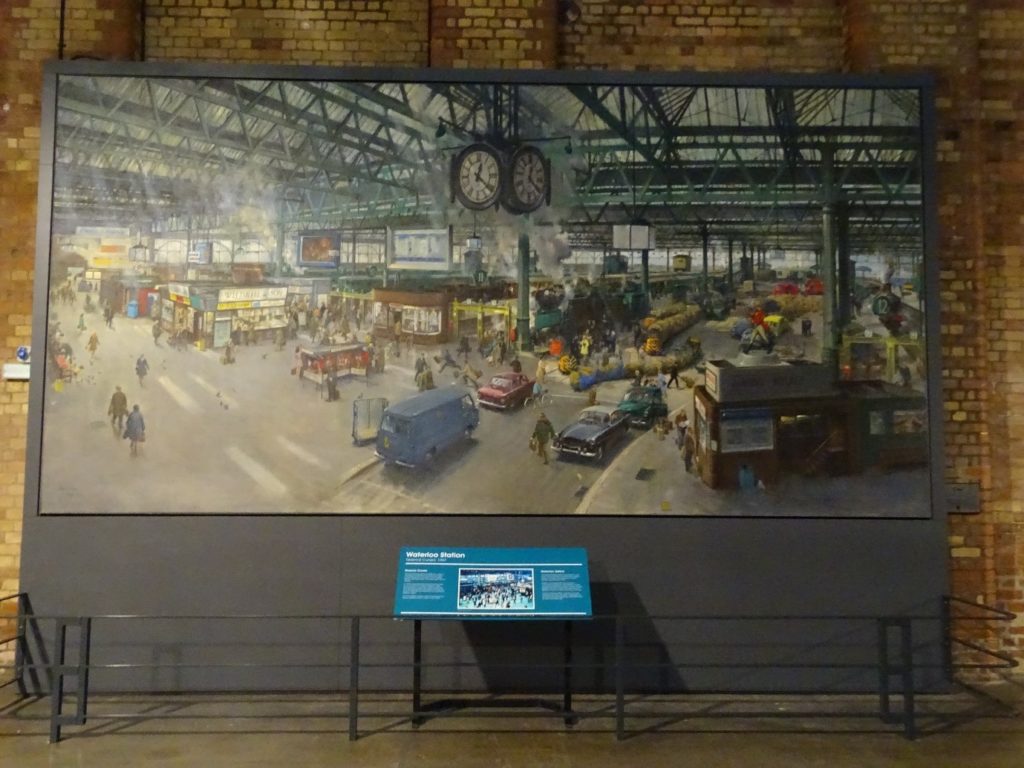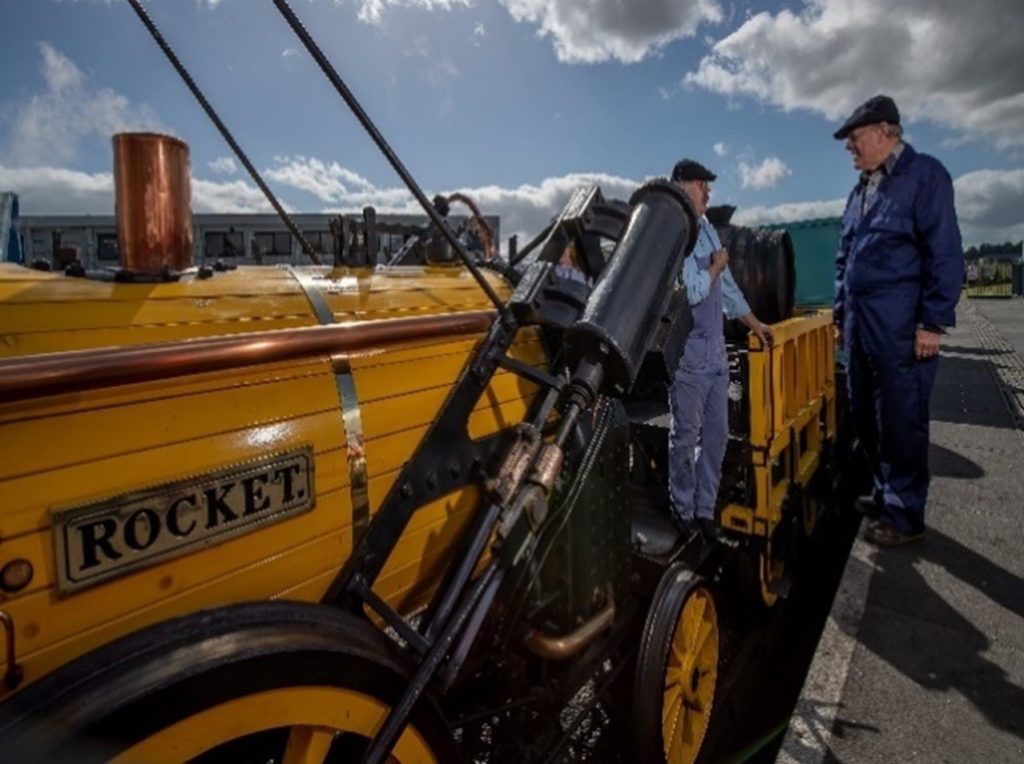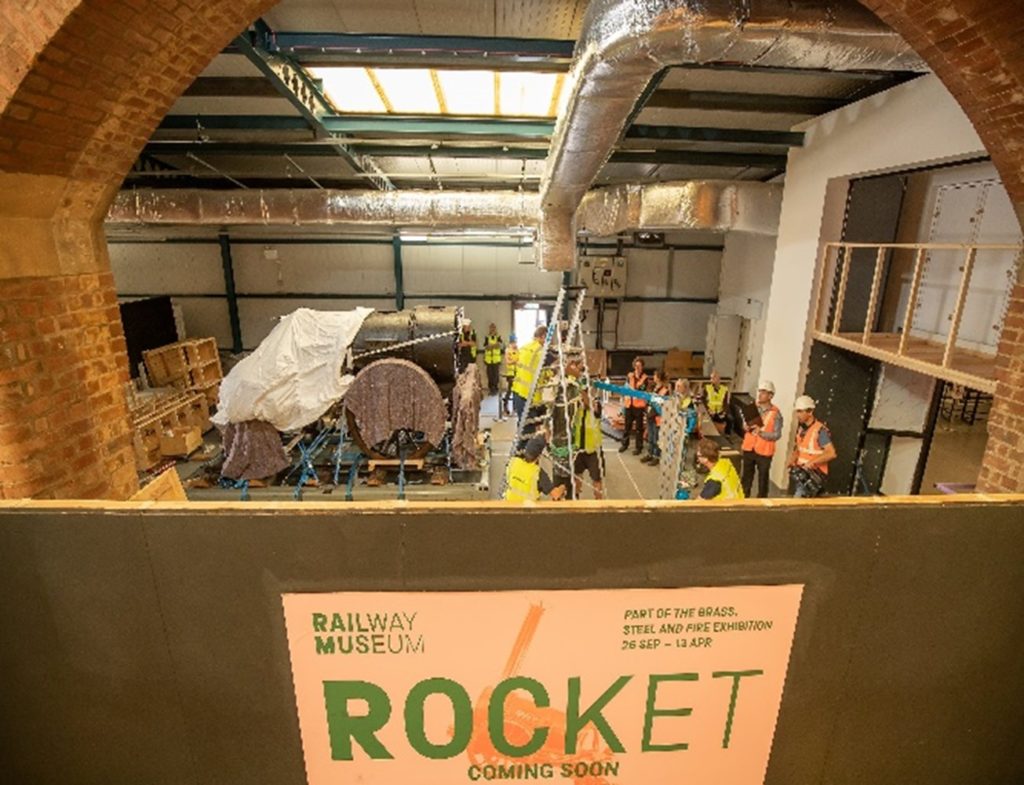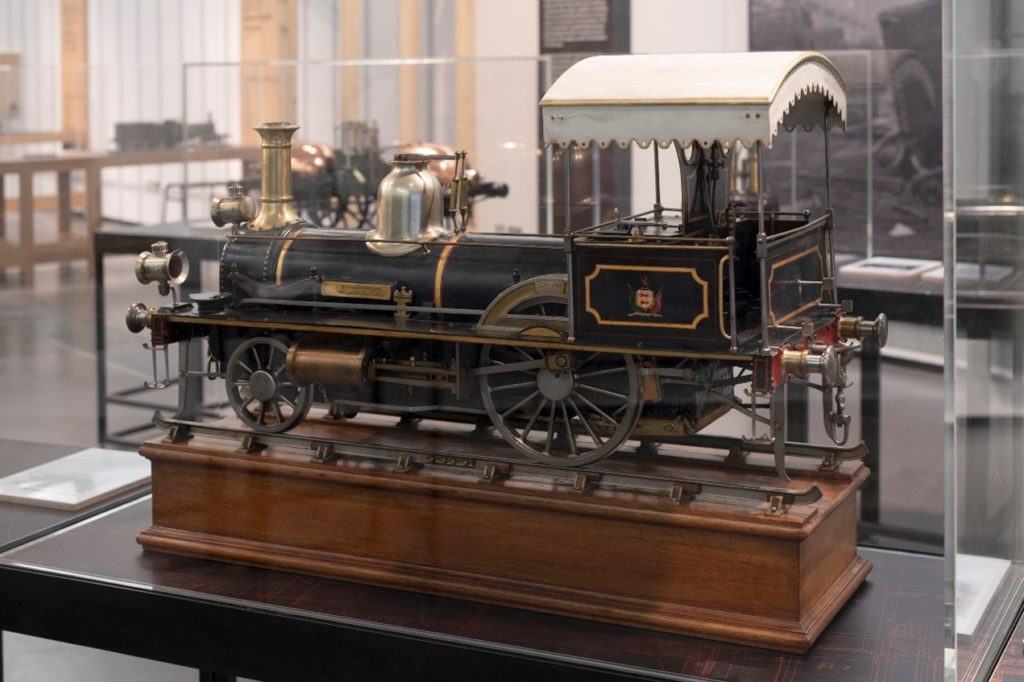Brass, Steel and Fire launched at the National Railway Museum in September 2019 and was viewed by thousands of people until the museum closed on 18 March 2020 in response to the escalating Covid-19 pandemic. The exhibition is now enjoying a new chapter at the Science Museum in London, from the museum’s reopening on 19 May until 30 August 2021.
To get up close to the original 1829 Rocket, it’ll be on display in Station Hall at the National Railway Museum from 19 May.
Brass, Steel and Fire merges style with a natural beauty, intrigue and industry. The exhibition is designed in a way that evokes an intimate workshop setting with some of the rarest and unique model locomotives to date. It invites you to sit and admire the models with small classroom chairs and magnifying glasses. It also has short films that allow you to hear and see the models in action. The main part of the exhibition is a collection of railway models, which leads to the original 1829 Rocket—arguably one large model as Stephenson did not have time to build a prototype before the Rainhill Trials.


The process of installing this exhibition was in three parts. The first was to move the largest painting in the collection and reframe it for display. The second was to install the original Rocket into its current position which coincided with a visit from actor Sir David Jason. Finally, the model locomotives were installed over the space of two weeks with the help of the in-house engineering team, technicians and collections team. The exhibition took 18 months of planning, design, research and conservation to complete and the physical installation took one month.

To house Rocket in Station Hall, the museum’s largest and one of the most popular paintings , ‘Waterloo’ by Terrance Cuneo, had to be moved and redisplayed. The painting blocked an archway towards a viewing area which now displays Rocket. This provided an opportunity to improve the display and position of the painting.
Originally, it was displayed on the promenade in the southern area of Station Hall, near to the doors which lead to the outdoor area of the museum called South Yard. The draught from the door caused a fluctuating environment in humidity and temperature which can cause a canvas to expand and contract and can affect the painting medium. It was also displayed on a timber cladding which was a distracting shade of green via wooden split battens which were then attached to the substrate.
Although the system successfully supported the painting, it sat proud from the wall which made it vulnerable to being knocked and touched by people.

The painting has been inserted into a painted metal frame. The painting itself is attached to the internal metal frame within a recess. The entire structure was engineered to engage exactly with the painting’s existing fittings. Using split battens to secure the weight and cause no undue stress to the canvas or existing framing, the design and conservation framing service also added a horizontal L-shaped metal rest brace, situated below the painting to add another layer of protection.
In the event of ground movement or sudden vibrations, the painting will drop onto the brace. Conservation-standard material was used for the redisplay. Both the metal and timber frame were painted with conservation-standard materials and the framing material was manufactured in zero formaldehyde-rated timber which will not off-gas and affect the painting.

The frame protects and buffers the canvas from extreme environmental fluctuations, and has been painted in a sympathetic shade of grey to elevate the painting. To stop visitors from touching the painting, we added a small unobtrusive metal barrier. Finally, the frame has a shadow gap around the painting which allows circulation of air to allow the canvas to breathe. The frame is easily removable so if the painting needs to be moved in an emergency, it can be done simply and quickly.

Ideally, the main function of a frame is to protect the canvas, its secondary and consequential function is to enhance the painting and to allow it to be enjoyed by the audience without the frame interfering with its interpretation. The painting has been moved approximately three metres further along the wall into a more central position in Station Hall.
The whole process of decanting and installation is available here to watch on time-lapse which included many museum colleagues including the Assistant Director Andrew McLean, and it was a hugely successful team effort.
As mentioned earlier, the installation of Stephenson’s Rocket was filmed by a TV crew and Sir David Jason. They asked if Rocket could be restored to steam. This is impossible for many reasons including the fact that it no longer has a boiler. Rocket is to be preserved in its current condition as a museum object. It remains stationary so that the object does not deteriorate and wear out though use and remains as close to the same engine Stephenson built as we can preserve. The locomotive is often surface-cleaned by the in-house conservation team which also allows the object to be constantly condition-checked.
The reason Rocket would never be restored to its original condition is because the fabric of that object would be irreversibly changed and less true to the original. We would also project our own 21st-century technology onto a 19th-century object. To show how Rocket would have looked in steam, a replica was built in 1979 in Springwell, Tyne and Wear, for the National Railway Museum and is currently on display and used for steam demonstrations and rides. This locomotive is overhauled regularly by the in-house engineering team at the National Railway Museum.


Rocket has previously been on tour, first at the Discovery Museum in Newcastle for the Festival of the North, then onto Manchester’s Science and Industry Museum and finally to its current home at the National Railway Museum. It was craned into the museum by specialist contractors and then carefully moved into position, where the chimney was bolted on. As a general rule, locomotives are not designed to fly, but Rocket coped well as its move had been meticulously planned by Louisa Burden, Group Head of Conservation & Collections Care, and Richard Horton, Engineering Conservator at the Science Museum.


Once Rocket was in place, the locomotive models, set and interpretation could be installed in the conditioned gallery. Each model in the exhibition had been carefully selected to tell a particular part of railway history. These models can be from kit form or produced from scratch and there are many such models in our collection. Most of the locomotives were in a good condition and needed only a surface clean using a museum vacuum and a soft brush, followed by careful installation into the gallery space next to Station Hall. Miniature chocks were used to wedge the wheels on the rails, just like the full-size locomotives in the museum.


One engine that did need a more intensive conservation treatment was the ‘Egyptian Locomotive’ built in 1862. With Arabic on one side and an English translation on the other side which reads the name of the prince governor ‘Tousson Pacha’, the model was used as a sales tool to persuade Egyptian railway companies to buy British exports. The full-size locomotive ran a service between Alexandria and Suez.
During the cleaning process, we discovered soot remains in the chimney which indicated that the object used to be in steam. The vehicle was in a very good condition apart from the parasol. Here, large flakes of paint were peeling away from the original surface and dropping away from the interior. The outside surface of the model was also starting to lift. The paint was consolidated, the large flakes were re-adhered, and areas of loss were filled and colour-matched using acrylic paint. The locomotive was cleaned, polished and a final layer of renaissance wax was applied which dried to a hard, clear surface.



Another object that was conserved as part of the exhibition was the painting of Thomas Greener. This had been located towards the rear of the museum’s art store and had been rarely displayed. It has now been conserved by a specialist painting conservator. The surface has been cleaned, the canvas had been stabilised and it has been framed and glazed for protection, to reveal a rather handsome gentleman. According to the conservator we now believe it to be a painted photograph.


The opening night itself involved a lot of preparation behind the scenes. The Rocket replica was cleaned and lit many hours before it was finally moved into position to where the exhibition team organised and positioned brilliant raking lights that brought the vivid colours to the forefront. It combined the senses of sound and smell to give guests a glimpse of how the locomotive would have looked when originally built. The opening night displayed a balanced harmony between conservation and restoration which is what makes the museum so unique.


The exhibition has been very well received since its opening date and has attracted a large and varied audience. It has also been a wonderful exhibition and project for all teams at the National Railway Museum and we are extremely proud of it. The exhibition has also received the Heritage Railway Association (HRA) Award for Interpretation. Although coronavirus cut the exhibition a little short in York, it is now on display with additional locomotive models at the Science Museum in London.
